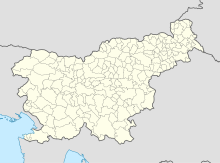Battle of Poljana
| Battle of Poljana | |||||||
|---|---|---|---|---|---|---|---|
| Part of World War II in Yugoslavia | |||||||
 Captured Germans, Ustaše, Chetnik, Slovene soldiers and civilians in Maribor after the battle | |||||||
| |||||||
| Belligerents | |||||||
| Axis and collaborationist forces: | Allies: | ||||||
| Commanders and leaders | |||||||
| | | ||||||
| Units involved | |||||||
| Strength | |||||||
| Mixed column of 30,000 Axis soldiers and civilians | Unknown | ||||||
| Casualties and losses | |||||||
| 350 killed, wounded or missing | 100 killed and wounded | ||||||
| Approximately 70,000 to 80,000 German, NDH, Chetnik, Slovene Home Guard soldiers and civilians massacred around Maribor | |||||||
Location of Poljana in Slovenia | |||||||
The Battle of Poljana took place outside of Poljana, near the village of Prevalje in Yugoslavia (modern-day Slovenia) between the Yugoslav Army and a column of 30,000 retreating Axis soldiers, which consisted of the German Wehrmacht, the Croatian Armed Forces (which consisted of Home Guard and Ustaše soldiers), the Montenegrin People's Army (which was of former Chetniks and survivors of the Battle of Lijevče Field), the Serbian Volunteer Corps, the Slovene Home Guard, the 15th Waffen SS Cossack Cavalry Corps and other collaborationist forces who where on their way to surrender to the British in Austria. The battle was one of the last confrontations of World War II in Europe taking place on 14 and 15 May 1945, 6 days after Germany unconditionally capitualated.
Background[edit]

By May 1945, the European Axis powers had been defeated. When word of the war's end spread, a mixed column of 30,000 Wehrmacht, Waffen SS, Ustaše, Domobrans, Chetnik, Cossack soldiers and their families began staging a massive retreat north towards Austria to surrender to the British, who they saw would help them seek sanctuary. German General Alexander Löhr and Croatian dictator Ante Pavelić both gave orders to continue fighting in the direction of Cilli in Germany (modern-day Celje in Slovenia) and to Klagenfurt in Austria.
Despite assurances from the Partisan leader Tito that all Axis prisoners would be treated accordingly, rogue Partisans began summarily executing ethnic Germans, Hungarians, as well as suspected Croat, Serb and Slovene collaborators. Tito gave orders to the 3rd and 4th Armies in Carinthia to cut off the escape route into Austria. What remained of German Army Group E (7 German, 9 Croat, and 2 Cossack divisions of the Waffen SS), as well as other collaborators and civilians continued their way to the British.
Battle[edit]

On May 14 shortly before 9:00 am, the 30,000 strong column of German, Croat, Chetnik, and Slovene soldiers smashed through the defense of Poljana, which was a small town close to the Austrian border. The dire situation rapidly deteriorated into a bloodbath with artillery being exchanged by both sides which went on into the night. Large number of skirmishes took place around the field surronding Poljana, with individuals and small groups fleeing to the hills to make their own way towards Austria while others fell to complete confusion and chaos.
Finally on the morning of May 15, around 20 British tanks arrived and both sides made negotiations. The white flag of surrender was finally raised at 4pm.[1] The Axis suffered 350 dead, while the Yugoslav Army only suffered 100 losses. It was one of the last battles of World War II in Europe and would be the culmination of the Axis retreat out of Yugoslavia.
Much to the horror of the column of Axis soldiers, the British made it harshly clear that they would not accept their surrender and instead they unconditionally surrendered to the Yugoslav Army. Britain, which at this point had tens of thousands of German, Ustaše, Chetnik, Cossack, Slovene soldiers and civilians in custody, handed the rest of their prisoners at gunpoint to the Yugoslav forces who began massacring the column in what became known as the Bleiburg repatriations.[2]
See also[edit]
References[edit]
- Notes
- ^ Franci Strle: Veliki Finale na Koroškem (2nd edition, 1977) p322-354
- ^ "Clash at Poljana – The WW2 Battle That Was Fought A Week After VE Day". MilitaryHistoryNow.com. 2013-10-09. Retrieved 2024-01-25.
- Bibliography
- Thomas, N., Mikulan, K. and Pavelic, D. Axis Forces in Yugoslavia 1941-45, Osprey, London, 1995. ISBN 1-85532-473-3


 French
French Deutsch
Deutsch